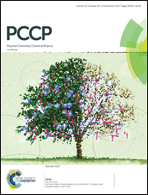A theoretical prediction on the shear-induced phase transformation of TKX-50†
Abstract
Dihydroxylammonium 5,5′-bistetrazole-1,1′-diolate (TKX-50) is a new and attractive energetic material that outperforms numerous common explosives because of its excellent properties and performance, and is thus a promising candidate to replace some of them. Nevertheless, knowledge of its physico-chemical properties, in particular, the underlying mechanism for it undergoing external stimuli for complete decay still remains poor. In the present study, we ascertain a preferred slip system of (010)/[101] and a shear-induced phase transition of TKX-50 with the aid of theoretical calculations. In other words, a new phase of TKX-50, γ-TKX-50, is observed to be formed by shearing TKX-50 along a slip system of (010)/[101] or (010)/[10![[1 with combining macron]](https://www.rsc.org/images/entities/char_0031_0304.gif) ] with a space group of P21/a, elevated energy of 9.4 kcal mol−1 and a unit cell expanded 4%, relative to the original TKX-50. Moreover, γ-TKX-50 can most readily be formed by shearing TKX-50 along (010)/[101] with a lowest energy barrier of 18.6 kcal mol−1, which is much below that for TKX-50 decay. The predicted elastic constants of γ-TKX-50 verify its mechanical stability with decreased mechanical anisotropy relative to the original TKX-50. In addition, we find that, after phase transition, the hydrogen bonding is weakened, while the electrostatic repulsion of Hδ+⋯Hδ+ increases, which disfavors the proton transfer from NH3OH+ to C2O2N82− to facilitate the thermal decay of TKX-50. This suggests that the shear-induced transition from TKX-50 to γ-TKX-50 can enhance thermal stability by elevating the energy barrier for proton transfer, potentially contributing to the low mechanical sensitivity of TKX-50. Hopefully, this study would enrich the insight into the underlying mechanism of TKX-50 against external thermal–mechanical stimuli. Moreover, in combination with the newly found heat-induced phase, the shear-induced phase observed in the present study and the original one, there are at least three phases for TKX-50.
] with a space group of P21/a, elevated energy of 9.4 kcal mol−1 and a unit cell expanded 4%, relative to the original TKX-50. Moreover, γ-TKX-50 can most readily be formed by shearing TKX-50 along (010)/[101] with a lowest energy barrier of 18.6 kcal mol−1, which is much below that for TKX-50 decay. The predicted elastic constants of γ-TKX-50 verify its mechanical stability with decreased mechanical anisotropy relative to the original TKX-50. In addition, we find that, after phase transition, the hydrogen bonding is weakened, while the electrostatic repulsion of Hδ+⋯Hδ+ increases, which disfavors the proton transfer from NH3OH+ to C2O2N82− to facilitate the thermal decay of TKX-50. This suggests that the shear-induced transition from TKX-50 to γ-TKX-50 can enhance thermal stability by elevating the energy barrier for proton transfer, potentially contributing to the low mechanical sensitivity of TKX-50. Hopefully, this study would enrich the insight into the underlying mechanism of TKX-50 against external thermal–mechanical stimuli. Moreover, in combination with the newly found heat-induced phase, the shear-induced phase observed in the present study and the original one, there are at least three phases for TKX-50.

- This article is part of the themed collection: 2017 PCCP HOT Articles


 Please wait while we load your content...
Please wait while we load your content...